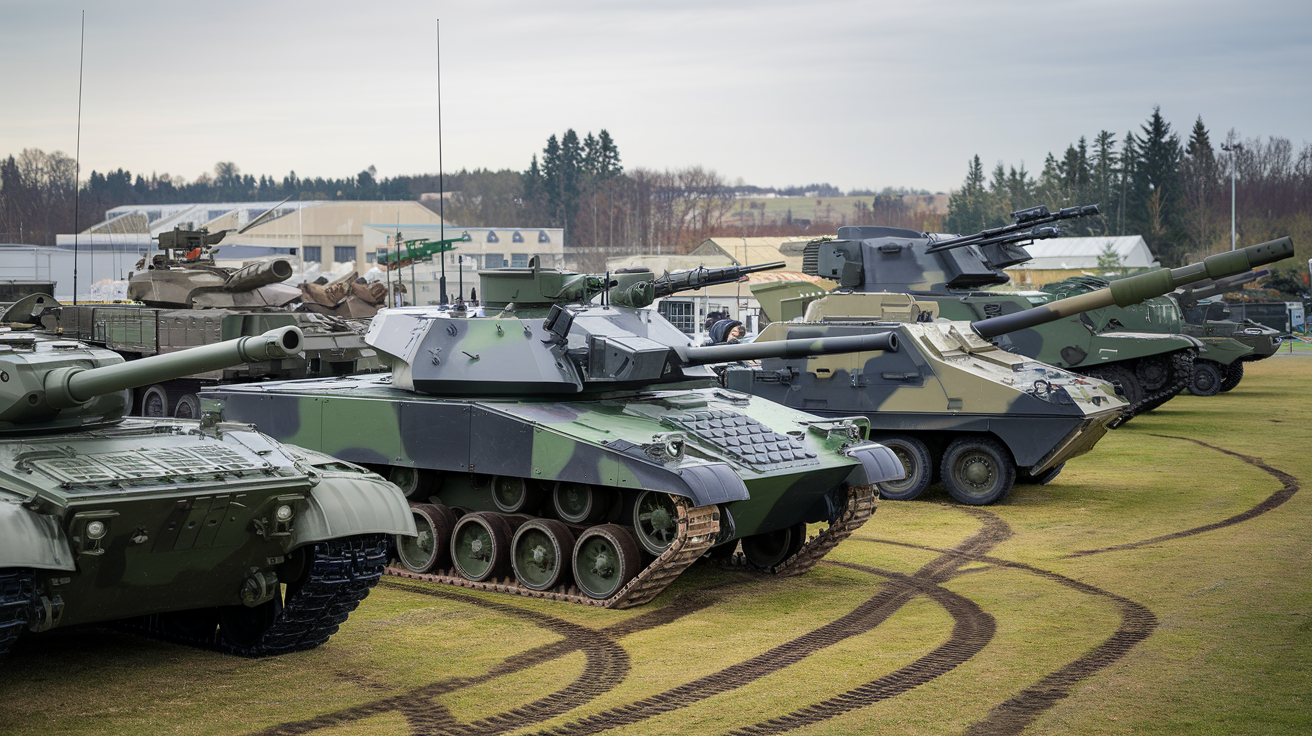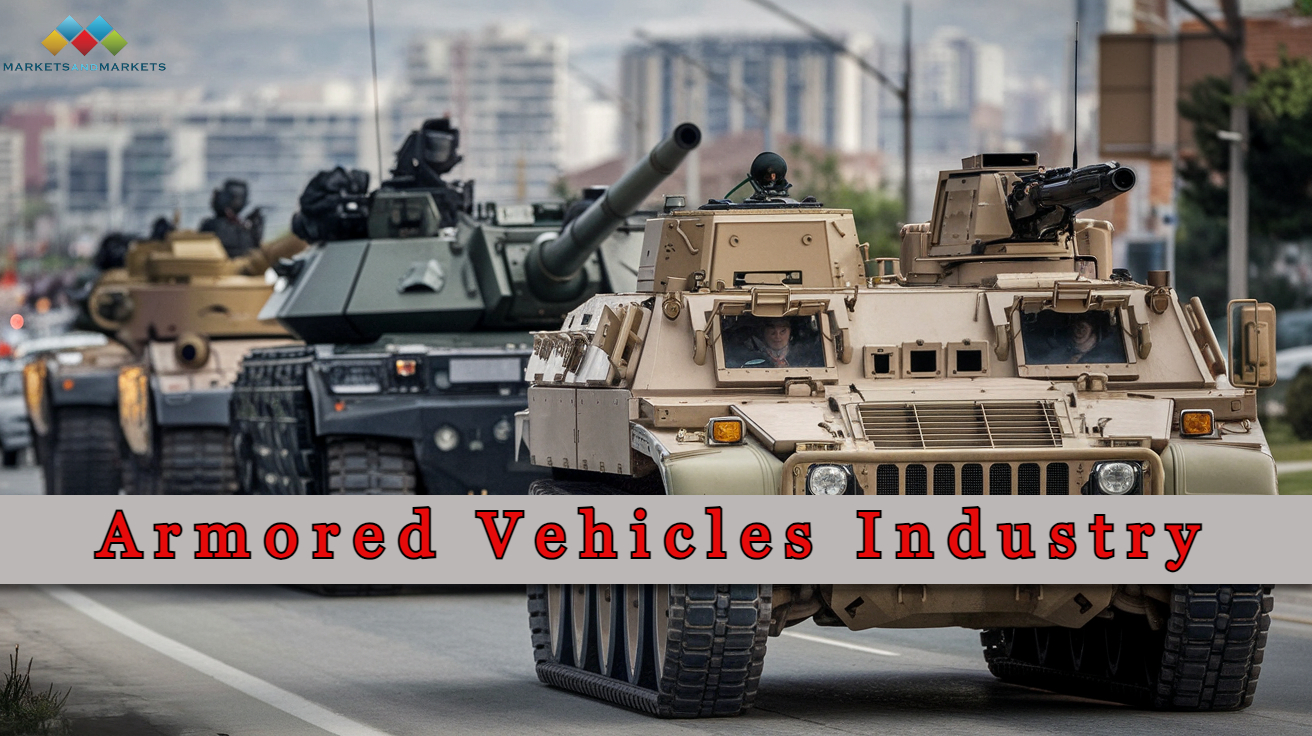Armored vehicles have evolved into an essential tool in military, law enforcement, and private sectors due to their unique blend of protection, mobility, and versatility. From safeguarding troops in combat zones to providing secure transport for high-profile individuals, armored vehicles are designed to withstand various threats, including ballistic, explosive, and chemical attacks.
This insight delves into the industry forecast, types, technology, applications, and future of armored vehicles.
The Armored Vehicles Market is valued at USD 51.6 billion in 2024 and is projected to reach USD 60.7 billion by 2029, at a CAGR of 3.3% from 2024 to 2029. The armored vehicle market experiences growth and evolution driven by various factors. Rising geopolitical tensions and terrorism prompt nations to enhance defense capabilities, fueling demand for armored vehicles. Global military modernization programs, aiming to replace aging fleets with advanced technology-equipped vehicles, boost market demand. Innovations in armor materials, vehicle design, and weapon systems attract investments and propel market growth.
Download Informative Insights @
https://www.marketsandmarkets.com/pdfdownloadNew.asp?id=6322755
Types of Armored Vehicles
Armored vehicles come in a variety of forms, each tailored to specific roles and operational needs:
- Military Armored Vehicles
- Main Battle Tanks (MBTs): These heavily armored and armed vehicles are the backbone of modern ground forces. They are equipped with large-caliber cannons, thick armor, and advanced fire-control systems to engage enemy forces. Examples include the M1 Abrams (USA) and the Leopard 2 (Germany).
- Armored Personnel Carriers (APCs): Designed to transport infantry safely across the battlefield, APCs offer protection against small arms fire and shrapnel. The M113 (USA) and the Patria AMV (Finland) are common examples.
- Infantry Fighting Vehicles (IFVs): More heavily armed than APCs, IFVs are designed to both transport troops and engage in combat. They are often equipped with auto-cannons, machine guns, and anti-tank missiles. The BMP-2 (Russia) and Bradley Fighting Vehicle (USA) are examples.
- Mine-Resistant Ambush Protected (MRAP) Vehicles: Built to withstand IEDs (improvised explosive devices) and landmines, MRAPs have specialized V-shaped hulls to deflect blasts. Examples include the Cougar and the Oshkosh M-ATV (USA).
- Law Enforcement and Civilian Armored Vehicles
- Armored Cars: Used by private companies and governments for transporting valuable goods such as cash, diamonds, or confidential documents, these vehicles have reinforced bulletproof windows and body panels.
- Armored SUVs and Sedans: These vehicles offer personal security for VIPs, politicians, and corporate leaders. They are designed to blend in while offering protection against small arms fire and explosive threats. Custom conversions of luxury models like the Mercedes-Benz S-Class or Cadillac Escalade are common.
Key Technologies in Armored Vehicles
- Ballistic Armor The core feature of any armored vehicle is its protective armor. Modern armor systems use a combination of materials to balance protection, weight, and mobility.
- Steel Armor: Traditionally used due to its strength, but often heavy, limiting speed and maneuverability.
- Composite Armor: Modern vehicles often employ layered materials, such as ceramic plates and kevlar, to offer high protection at a lower weight.
- Reactive Armor: This involves explosive tiles that detonate outward when struck by a projectile, reducing the impact of anti-tank rounds.
- Active Protection Systems (APS): Advanced vehicles use APS like the Trophy system, which detects and intercepts incoming threats, such as RPGs, before they hit the vehicle.
- Weaponry and Fire Control Systems Armored vehicles are equipped with state-of-the-art weaponry systems to ensure combat readiness:
- Cannons and Machine Guns: Mounted on military vehicles for engaging infantry and armored threats.
- Missile Systems: Advanced IFVs and MBTs may also carry guided missile systems for long-range engagements.
- Fire Control Systems: These systems integrate sensors, radars, and computer algorithms to enhance targeting accuracy in dynamic battlefield conditions.
- Mobility and Engines
- Tracks vs. Wheels: MBTs and heavy armored vehicles often use tracked systems for enhanced off-road mobility, while lighter vehicles may use wheels for better speed and fuel efficiency.
- Hybrid and Electric Engines: With increasing environmental concerns and the need for longer operational range, research into hybrid and fully electric armored vehicles is gaining momentum.
- Communication and Surveillance Systems Armored vehicles are now integrated with advanced communication systems that allow for real-time data sharing, battlefield awareness, and coordination with other units. Many vehicles are equipped with surveillance cameras, infrared sensors, and radar to detect and track potential threats.
Applications of Armored Vehicles
- Military Operations
- Armored vehicles are indispensable in modern warfare. They provide critical support for infantry, enhance the firepower of military forces, and are instrumental in both offensive and defensive operations.
- In peacekeeping missions, APCs and IFVs offer protection to soldiers in volatile regions while enabling humanitarian assistance.
- Counter-Terrorism and Law Enforcement
- Armored vehicles are often used by SWAT teams and other law enforcement agencies for hostage rescues, anti-terrorism operations, and crowd control.
- Civilian armored vehicles, such as bulletproof cars, are commonly used for transporting high-value assets or providing secure transportation for dignitaries.
- Private Security and VIP Transport
- High-profile individuals often face threats from kidnapping, terrorism, or criminal organizations. Armored SUVs and sedans provide discreet yet effective protection without sacrificing luxury or comfort.

Challenges Facing Armored Vehicle Development
- Weight vs. Mobility While increased armor offers better protection, it also adds weight, reducing speed and agility. Striking a balance between protection and mobility is a constant challenge for designers.
- Cost Armored vehicles, especially advanced military ones, are expensive to produce, maintain, and operate. This can place a heavy burden on national defense budgets, particularly for countries with limited resources.
- Evolving Threats The development of new anti-armor weaponry, such as guided missiles and drones, requires continuous innovation in armor technology. Active protection systems, like those that intercept incoming projectiles, are becoming essential in modern armored vehicles.
Future of Armored Vehicles
- Autonomous Armored Vehicles The next generation of armored vehicles is likely to see increased automation, with some vehicles operating autonomously or semi-autonomously. Autonomous vehicles could conduct reconnaissance, supply delivery, or even combat missions with reduced risk to human life.
- Advanced Materials Researchers are exploring the use of nanotechnology, graphene, and other cutting-edge materials to create lighter, stronger, and more adaptive armor. These materials will allow for faster, more maneuverable vehicles with enhanced protection.
- Integration with Drones and Robotics Future armored vehicles may work in tandem with unmanned systems, such as drones or ground robots, to enhance battlefield awareness and tactical capabilities. These systems will offer new ways to gather intelligence, disrupt enemy operations, and provide direct fire support.
Top Leaders in Armored Vehicles Industry:
The Armored Vehicles market is dominated by a few globally established players such as
- Rheinmetall AG (Germany)
- General Dynamics Corporation (US)
- Oshkosh Corporation (US)
- BAE Systems (UK)
- Hanwha Defense (South Korea)
Ask for Sample Report @
https://www.marketsandmarkets.com/requestsampleNew.asp?id=6322755
Armored vehicles have become an indispensable asset across military, law enforcement, and private sectors. As threats evolve and technology advances, armored vehicles will continue to be at the forefront of security and defense operations. From traditional tanks to futuristic autonomous systems, their development will shape the future of warfare and personal security.

